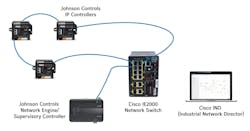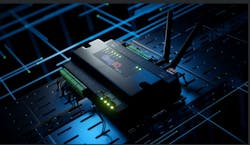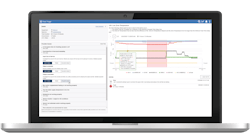Navigating Building Resiliency Across Evolving Customer Needs
By MEL MENKE, Senior Product Manager, Johnson Controls
Delivering highly resilient building systems in today’s evolving world looks very different from even just a few years ago. Modern resilient solutions go well beyond just keeping building conditions warm or cool; they leverage the data from the building automation system (BAS) to intelligently respond to changing conditions, thus helping to prevent potential catastrophic losses associated with failing HVAC equipment and other building assets.
Growing industry expectations
Building resiliency has evolved from a simple model. The basic needs of a building used to be limited to controlling temperature, humidity and airflow. Resiliency meant ensuring these fundamental outcomes were consistently delivered through the use of backup systems or a BAS to optimize building conditions. The focus was keeping conditions constant and spaces comfortable for people within the building. If there were any failures or downtime, they were managed retroactively.
Today, more devices and functions are integral to a building, since they are all connected.
Video surveillance, access control, fire detection and lighting systems are commonly integrated with the BAS. Resiliency is no longer considered nice-to-have. It is now a must-have. That means no devices or systems are going offline, even for a second. It’s having everything continue to run in an automated way without any manual intervention. Even in buildings without any critical spaces, this level of resiliency is now expected.
Resiliency benefits all buildings
More and more buildings that haven't traditionally required high levels of resiliency now do, especially as both HVAC and non-HVAC systems converge on shared IP or IT networks. Resiliency standards once reserved for buildings such as data centers and large enterprises are becoming the norm across almost all building types.
Consider warehouses, K-12 school buildings, or commercial office buildings. If certain systems go offline, for even a short time, major disruptions occur. While not traditionally a major building event, the negative operational impact to the school day if the badging system or security cameras malfunction, even for just a few minutes, becomes palpable. Similarly, HVAC operational disruptions in a manufacturing facility could impact employee productivity and safety. In an office building, overheating computers or servers might cause systems to shut down to protect critical assets. Any moment of disruption could have long lasting and expensive impacts.
Now think about the critical spaces in a hospital. Any one device going offline in such a setting can become catastrophic. Conditions for operating rooms and intensive care units are regulated by codes and standards. Improper air circulation could create a breeding ground for infection, putting critical patients at extreme risk.
In the age of COVID-19, building resiliency becomes even more important in a healthcare facility. If the HVAC system goes down, the negative pressurization required for isolation rooms cannot be achieved. Now, buildings of all types are beginning to integrate microchips into badges for safety. These can alert building operators to rooms or zones that are near capacity and then disperse or relocate employees for their safety. System outages or failures would prevent this from happening.
In another example, financial institutions require the highest IT security standards for their systems. A system component going offline could result in security breaches and significant financial and reputational losses.
Levels of resiliency
Historically, HVAC solutions were designed to perform specific functions – at the best possible price and with the fastest installation in mind. Today’s modern buildings integrate HVAC systems and access control, fire, security, lighting and even specialty systems with the BAS (instead of as separate “functions”), making achieving resiliency seemingly more difficult.
But determining the right method for achieving resiliency according to each building installation’s unique needs becomes much easier by likening it to walking up a staircase. At the bottom is the logical starting point, achieved with physical BAS hardware or communication redundancy (or both). At the top are cloud-based solutions that perform predictive analytics. Let’s look at each.
Redundant communication at the controller level can be the simplest way of achieving resiliency. This can be accomplished in two ways:
- An Ethernet-enabled network topology; specifically, when controllers are connected in an Ethernet ring, or
- Through chosen wireless communications protocols, like Wi-Fi.
A failure or impact of the failure is minimized by the nature of the network design and the selection of these options. Additionally, advanced BAS equipment controller platforms will support and leverage the latest IT network and security standards to achieve reliable resiliency.
The next level of resiliency is achieved with the BAS software. Easy-to-navigate dashboards will clearly identify high priority issues so that building operators can troubleshoot them before they become costly outages.
At the topmost level, cloud-hosted analytics give operators the ability to monitor all their buildings, whether in a single location or across a geographical footprint, and use this enterprise functional data – collected from the BAS – to analyze and predict a potential failure within the system before it occurs.
Designing for resiliency
Besides the more extreme consequences of weak resiliency previously discussed, here’s something that’s true for all building operators: They would much rather proactively service a piece of equipment that has been identified with the potential to fail, during normal working hours, than service that piece of equipment in the middle of the night after it has already failed.
Mechanical engineers who take an expanded approach to designing systems so they are resilient will prevent retroactive, after-hours repairs from happening. Leading BAS providers deliver offerings to meet these different levels of resiliency requirements based on customers’ specific building management needs. Recommended steps:
- Install the right infrastructure for redundant or reliable communication. When using Ethernet- or IP-based controllers, hardware communication can be made redundant by connecting each device in a star topology. While this ensures any type of hardware or communication link failure is limited in its impact, it can become expensive to implement. Installing in a daisy chain topology helps minimize cost, but a potential failure will impact the resiliency of the system. Using a ring topology, especially with Media Redundancy Protocol (MRP), helps achieve the right balance between cost and resiliency. The Johnson Controls MRP Ring-Enabled IP Controller Solution achieves this balance.
- Build from a controller platform that uses the most advanced communication protocols. When thinking about advanced communication protocols for buildings, Ethernet is typically considered the “wired” solution, and Wi-Fi is considered the leading wireless solution. Both are industry-leading, state-of-the-art protocols that are IoT- and IT-ready, since they are both already heavily used in enterprise installations. With significantly more Operations Technology communication passing through IT networks, IT communication standards are now expected in both domains. For example, the MQTT protocol is used for data exchange between devices and server applications. It keeps communication bandwidth requirements to an absolute minimum, handles unreliable networks and is, therefore, ideal for machine-to-machine communication. The EasyIO controller platform by Johnson Controls is an example of a forward-looking BAS solution that supports these advanced technologies.
- Leverage BAS software to monitor and control building data. BAS software monitors and controls building conditions using the data collected from the IoT-ready controllers and communication-resilient design. Leading BAS software will identify building system-related faults and list them in order of severity by leveraging pre-defined rules and other data. It will also further prioritize faults by informing operators of fault duration and occurrence. Features like these, which are available as part of Metasys Fault Detection and Fault Triage, help operators identify issues of building systems that are not operating correctly, prevent energy waste, and avoid comfort complaints. They also suggest possible root causes and appropriate corrective actions.
- Expand to the cloud to analyze and predict. With the IoT-ready BAS now monitoring, displaying and controlling current and historical building information, building operators are equipped to use that information to make smart, informed decisions. How can the information collected be used to optimize enterprise-wide performance? Cloud-based building data analytics platforms use the data collected from the BAS and energy meters to proactively monitor and analyze building energy, equipment and space data to identify issues, faults and opportunities for improved energy performance, operational savings, and tenant experience.
##########
Based in Milwaukee, the author joined Johnson Controls in 2015 and has over 30 years' experience in the communications technology industry. In his current role, Menke is responsible for all styles of communications networking, whether wired or wireless.



